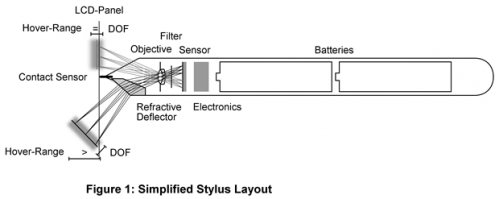July 24, 2012 weblog
Microsoft camera-based stylus seeks accuracy in sea of pixels

(Phys.org) -- To the multitouch screen generation, the stylus PDA tool of the past century seems like a quaint relic. While most mobile devices and laptops then moved away from stylus-friendly touchscreens, signs are here that touch interaction using the stylus is due for a comeback. The stylus has become a focus for innovation. Samsung has offered a stylus accessory for its Galaxy devices and there are stylus accessories for the iPad. The latest stylus news, though, belongs in Microsoft’s corner where researchers at Microsoft Research are working to make the stylus more accurate and more useful than ever before.
Their idea is a stylus that could work on all screens, even nontouch screens, on laptops, tablets, and phones. They are aiming for not only screen flexibility but also for accuracy. Microsoft’s stylus can accurately track individual pixels on an LCD display The real differentiators in the Microsoft design are the location tricks the stylus can use to “find” itself in a sea of pixels. A camera in the stylus determines which pixels are in and out of focus, and sends the information back to software which translates where the stylus is being placed on the screen, including the angle. The camera captures images of the display at a resolution of 512×512 pixels. By using the grid of pixels that make up the display, the stylus can count the pixels as they move past the camera’s field of view in order to precisely track movement in any direction. The grid of pixels is turned into a navigational guide. The camera, in tracking at a pixel level, allows for a more accurate stylus. Andreas Nowatzyk and Anoop Gupta got the idea of using this grid of pixels that make up a display as a navigational system.
Still in development, though, the camera-based stylus requires work ahead. The hurdle that Microsoft researchers need to resolve now is pressure sensitivity and the risk of cracked screens, especially displays fused to thin layers of glass.
According to Technology Review, another bridge to cross has to do with the image sensor to test prototypes. Compared to a good-quality wireless mouse using a compact image sensor with a resolution of 30x30 pixels, the stylus design that the Microsoft researchers have in mind would require one with a resolution of 512x512 pixels, to see the details as small as a tenth of a millimeter and to capture images at a high rate to track motion smoothly. The next development step “requires making that chip," said Nowatzyk. He also said that no decision has been made on whether or not to develop the design into a product.
More information:
via Technology Review
© 2012 Phys.org





















